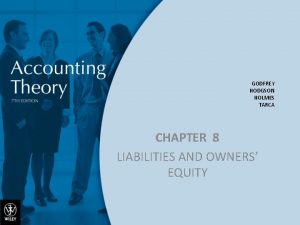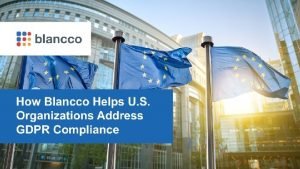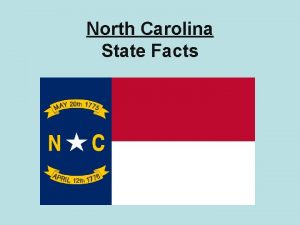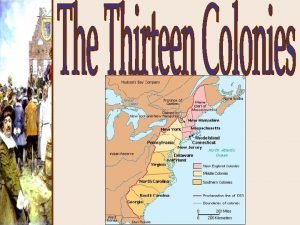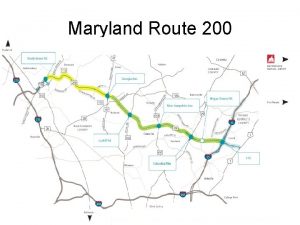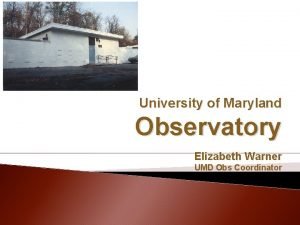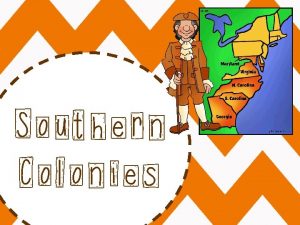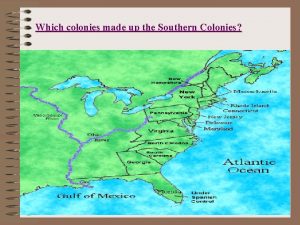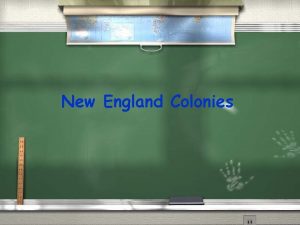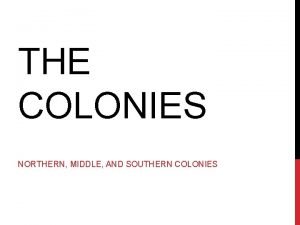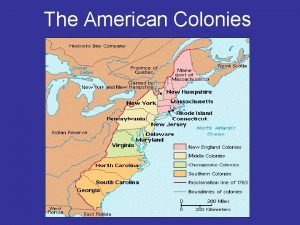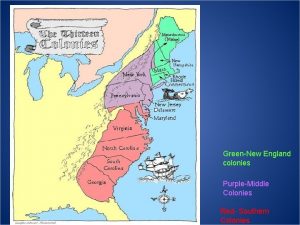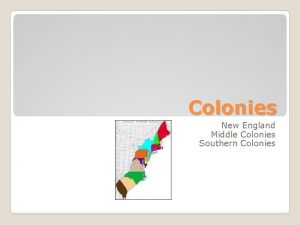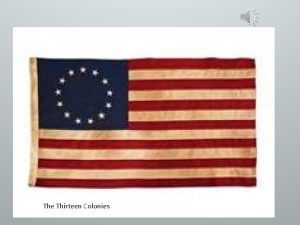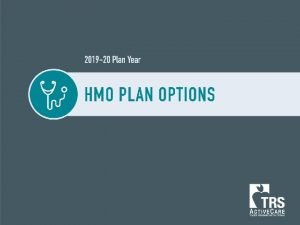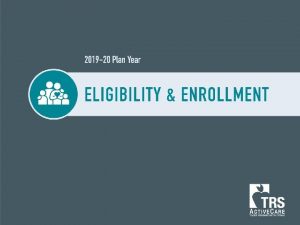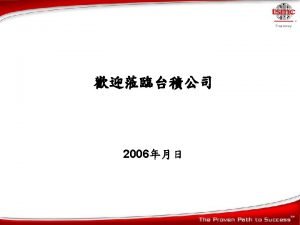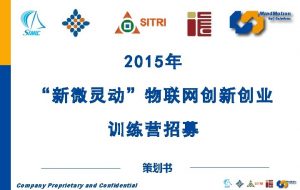THE COLONIES Part II The Proprietary Colonies Maryland





















- Slides: 21

THE COLONIES Part II

The Proprietary Colonies Maryland § 10 million acres granted by King Charles I in 1632 to the Calvert family (Lords Baltimore) § Named for King Charles wife, Queen Mary § Catholic supporters of the King § First settlement at St. Mary’s at the mouth of Potomac in 1634

The Proprietary Colonies Differences from Virginia § Proprietary colony (owned by someone) Calverts intended to carve their land into feudal-type manors § Calverts appointed all civil officers § § Encouraged settlement by Catholics Only English colony with a substantial Catholic minority § Catholics came to dominate Maryland’s House of Delegates (1635) §

Proprietary Colonies Similarities to Virginia § Tobacco plantation economy created large demand for land labor § 1640 Maryland adopted a system of headright grants § By 1670 s, Maryland’s population numbered more than 15, 000 § Indentured Servants: People who, in exchange for passage to the colony, promised to work for a set number of years (2 -7) Usually unskilled laborers, but some skilled, some orphans, some single women. § 2/5 of servants usually died before period of indenture was over. §

Slavery � � African slaves first brought to Virginia in 1619 More expensive, at first, than indentured servants Not a lot of difference in treatment between the two at first. Slavery grew very slowly during the 17 th century.

The Proprietary Colonies Carolina § Established by Charles II in 1663 § Originally stretched from Virginia to Spanish Florida § Carolina proprieters (8 noblemen) § 1664 – Appointed a governor and created a popularly elected assembly § 1669 - “The Fundamental Constitutions of Carolina “ Set up a manorial system § Originally governed by a small number of nobles. §

The Proprietary Colonies North Carolina � Settled mostly by poor families and run-away servants from Virginia � Small farms, rather than the manors the proprietors had hoped for. � Several of the proprietors gave up

The Proprietary Colonies South Carolina Anthony Ashley Cooper, Earl of Shaftesbury � Convinced partners to finance migrations to Carolina � 1670 – 300 colonists headed to Carolina from England � 100 survived the voyage � Settlement near present Port Royal � 1680 founded the city of “Charles Town” at the junction of Ashley and Cooper Rivers

The Proprietary Colonies � � � North and South settlements developed separately and differently North was primarily backwoods farmers with little dependence on slaves South developed a prosperous plantation economy and an “aristocratic society” Prosperous trade in corn, lumber, cattle, pork, and rice (principle crop after 1690) South developed close trading ties to Barbados � Slave trade encouraged by proprietors

The Proprietary Colonies � � � Frequent friction between Northern and Southern settlements. Colonists seized control of colony after Earl of Shaftesbury’s death in 1719 1729 – King George II took control and divided the colonies into North Carolina and South Carolina

The Proprietary Colonies New York � Originally settled by the Dutch West India Company in the 1640’s – Dutch settlement along the Hudson River � 1664 – King Charles II gave his brother James (Duke of York) all the territory between the Connecticut and Delaware Rivers (which included the Dutch settlement at New Amsterdam) � England resented the Dutch settlement which was right in between it’s northern and southern colonies

The Proprietary Colonies New York � 1664 – English fleet sailed into the undefended port of New Amsterdam � Unpopular Dutch governor, Peter Stuyvesant surrendered without a fight � Articles of Capitulation promised that Dutch settlers could stay. � Dutch briefly reconquered in 1673, but lost it for good in 1674. � James renamed the colony “New York”

Proprietary Colonies New York � Very diverse colony � Dutch & English � Scandinavians, Germans, French, Africans, Native Americans � Many different religious faiths � James delegated powers to a governor and council, but no representative assembly � Religious toleration � Highly fractious society � By 1685, New York had about 30, 000 residents.

The Proprietary Colonies New Jersey � Originally part of the New York charter of 1664 � James ceded a large portion to political allies Sir John Berkeley and Sir George Carteret (all 3 had been Carolina proprietors) � Territory named “New Jersey” after the island of Jersey in the English Channel � In 1702, proprietors ceded control back to the English crown due to constant bickering. � Also had great religious and ethnic diversity � Most of it’s residents were small farmers � No good harbor, so no important cities.

The Quaker Colonies Pennsylvania � Established by dissenting English protestants � Quakers – Society of Friends � Originated in mid-17 th century England � So-named because founder George Fox urged them to “tremble at the name of the Lord. ” � Did not believe in predestination or original sin � Women were considered equal in the church � Most anarchistic and democratic: no church hierarchy � Ardent pacifists – refused to fight

The Quaker Colonies Pennsylvania � William Penn � Son of British Admiral � Converted to Quakerism � Wanted to find a place where Quakers could live in peace � � 1681 – Inherited a large debt FROM the King, who paid with a grant of land between New York and Maryland. Colony named “Pennsylvania, ” after Penn’s father.

The Quaker Colonies Pennsylvania � Penn personally sailed to Pennsylvania and laid out the streets of the “City of Brotherly Love” � Encouraged settlement by a diverse group of settlers � Made sure the Native Americans were fairly paid for their land.

The Quaker Colonies Delaware § By 1690 s some residents beginning to complain of the absolute power of Penn § Penn agreed to a “Charter of Liberties” § established a representative assembly in 1701 (one house) § Allowed 3 “lower counties” to establish their own assembly, which they did in 1703 § While they had separate assemblies, Delaware and Pennsylvania continued to share a governor until the Revolution.

Georgia � � � The last colony founded (1732) Founded by General James Oglethorpe and a group of unpaid trustees to provide a military border between the English colonies and Spanish Florida Provide a refuge where poor men and women could begin anew. Felt that debtors could become the farmer-soldiers of a new colony 1732 - King George II granted Oglethorpe the land between the Savannah and Altamaha Rivers

Georgia Colonization Policies: • Limited the size of landholdings to keep colony compact and easy to defend • Excluded Africans, free or enslaved • Prohibited Rum • Strictly controlled trade with the Native Americans • Excluded Catholics Displeased colonists began calling Oglethorpe “our perpetual dictator”

Georgia Oglethorpe gradually loosened his grip § 1750 – removed the ban on slavery § 1751 – removed the ban on rum § 1751 – Oglethorpe returned control of the colony to the King § 1751 – King allowed a representative assembly § 1770 – 20, 000 non-Indian residents of the colony, nearly half of them slaves.
 Confidential & proprietary
Confidential & proprietary Advantages and disadvantages of oss
Advantages and disadvantages of oss Assura inc
Assura inc Proprietary theory
Proprietary theory Confidential do not distribute
Confidential do not distribute Proprietary format
Proprietary format Proprietary freeware
Proprietary freeware Define proprietary colony
Define proprietary colony Part to part ratio definition
Part to part ratio definition The part of a shadow surrounding the darkest part
The part of a shadow surrounding the darkest part Part part whole
Part part whole Minitab adalah
Minitab adalah Technical description examples
Technical description examples Part part whole addition
Part part whole addition Footed ware glass types
Footed ware glass types What is the state bird of north carolina
What is the state bird of north carolina North carolina marschland
North carolina marschland University of maryland
University of maryland Maryland physician health program
Maryland physician health program Toll road 200 maryland
Toll road 200 maryland University of maryland observatory
University of maryland observatory Capitol raceway crofton
Capitol raceway crofton



